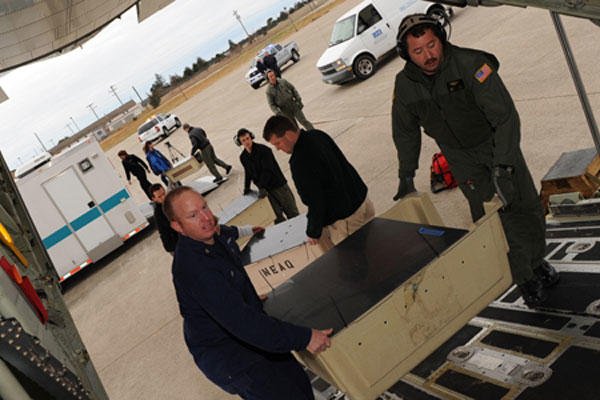It was an emergency wildlife mission. A bunch of sick, cold Northeast turtles were stuck in Cape Cod trying to swim south and needed a quick lift to Florida. The Coast Guard heeded the call with a C-130J Hercules based out of Elizabeth City, N.C.
“I know we’re just the bus drivers,” said Lt. Jon McCormack, pilot for the C-130J turtle transport flight. “However, we’re happy to be able to help and make a difference in bringing these sea turtles so they can be safe and thrive in their natural environment.”
“As part of our supporting our living marine resource missions, the Coast Guard works with federal and state partners in times of need such as when animals are stranded or entangled,” he added.
More than two dozen New England Aquarium staff, volunteers and Coast Guard crew braved the cold to quickly load up the airplane at Cape Cod, Mass., with 35 “cold-stranded” endangered turtles nested in blanket-lined fruit boxes and makeshift pet crates. For tracking, each turtle had a painted white number on its shell.
The 70-pound Loggerhead and the smaller five to 10-pound Kemp’s Ridley turtles are in various stages of recovery from pneumonia and hypothermia. A record stranding of more than 200 sea turtles off the Northeast coast in early winter exceeded the New England Aquarium’s capacity to house the nearly comatose reptiles. Sensing urgency, the NOAA Fisheries Northeast Stranding Network facilitated a request for the emergency flight.
“If it were not for the USCG transport of 35 turtles to Florida we would be in a series crisis for rehabilitation space for these endangered and threatened sea turtles,” said Connie Merigo, director of the rescue department at the New England Aquarium. “Sea turtles continue to strand here in Massachusetts almost 20 more in the past few days.”
An hour later, as the C-130’s ramp slowly closed shut, aquarium staff and Coast Guard crews standing on the runway waved their farewells to the airpalne and its precious cargo bound south for the Sunshine State.
Touching down at sunny 80-degree Orlando, Fla., a motorcade of five aquariums and marine wildlife centers, including SeaWorld Orlando, lined up by the plane ramp. As soon as the bright sunshine and warmth hit the turtles, they stirred restlessly in their crates and boxes while being carried out.
On the ground, the numbered reptiles were sorted through rosters and quickly claimed their “adoptees.” The turtles were finally home, as they should be, for the holidays. In a few months, they’ll be released back to the wild.
Aside from being beautiful creatures, the importance of sea turtles cannot be underestimated. They are an integral part of the marine ecosystem helping to restore beach habitat, to manage sea vegetation and are crucial to the predator-prey food chain.
“By helping to protect and rescue endangered and threatened marine wildlife, the Coast Guard supports its living marine resource missions,” said Capt. Mark Ogle, Atlantic Area future operations branch chief. “The preservation of sea turtles is vital to the health of our oceans and fisheries.”
Inherent to their nature, sea turtles grow up to learn how to swim, but for this special mission, they learned how to fly.





























